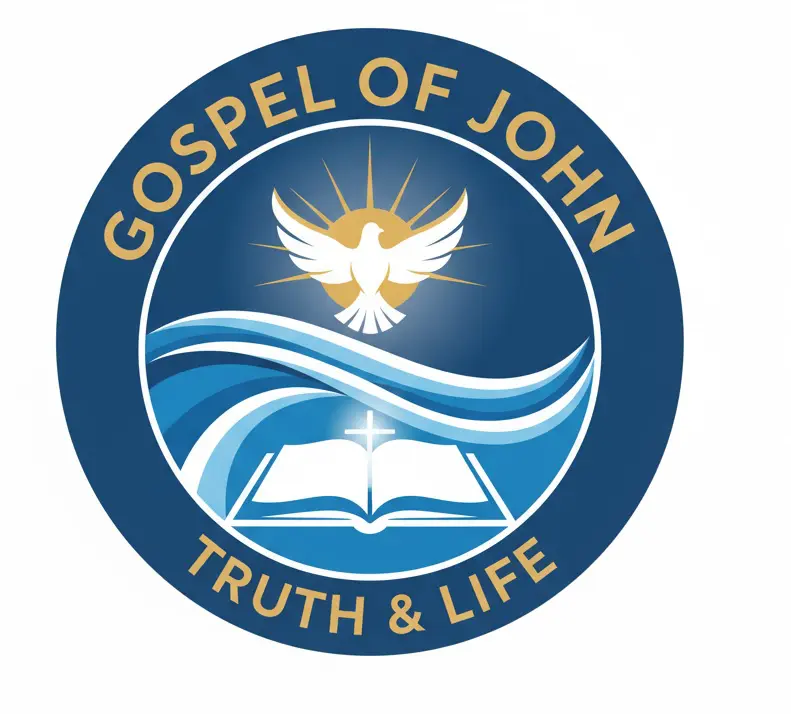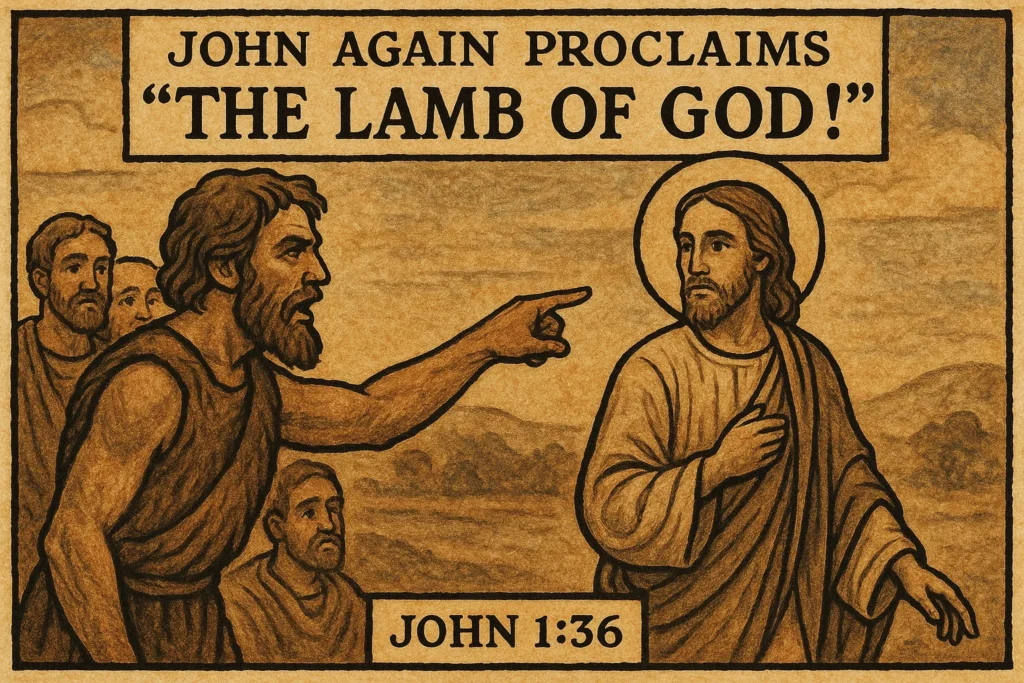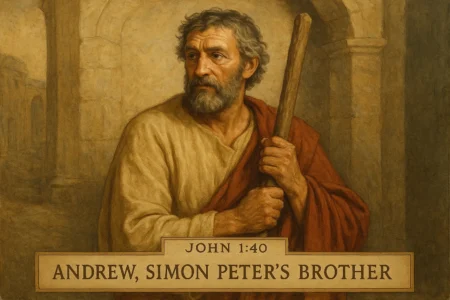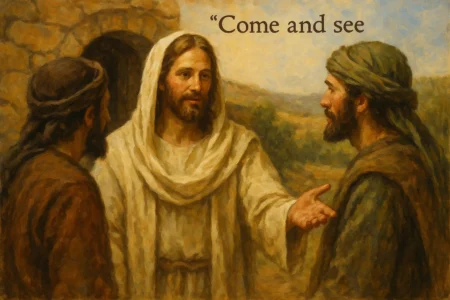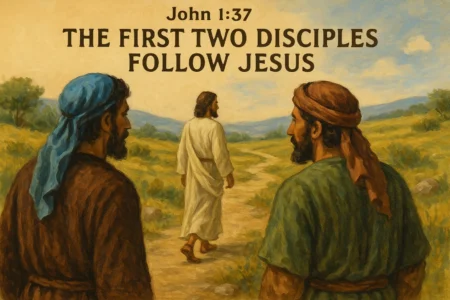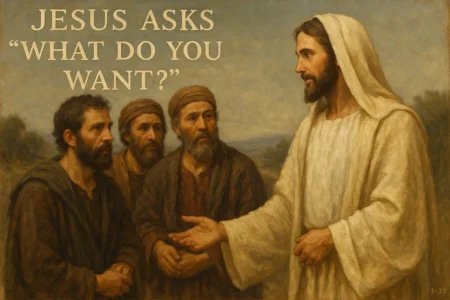It’s a dusty, sun-baked afternoon by the Jordan River. The crowds have thinned out. That electric energy from yesterday, when John the Baptist was thundering about repentance, has settled. It’s quieter now. An air of expectation hangs in the heat.
John is standing with two of his guys. Two of his inner circle. These are men who have dropped everything—their jobs, their families, their entire futures—to follow this wild prophet into the wilderness.
Then, he sees him.
Jesus is just… walking. Passing by. There’s no halo. No booming voice from heaven this time.
Just a man walking.
John’s gaze locks on. He stops everything. And he says it. He doesn’t shout it to the world. He says it to his two followers. “Behold the Lamb of God!” (John 1:36).
Now, if you’ve been reading the Gospel of John from the beginning, this is a record-scratch moment. You’re thinking, Wait a minute. Didn’t he just do this?
You’re right. The day before, in John 1:29, John saw Jesus coming and made this massive public announcement: “Behold the Lamb of God, who takes away the sin of the world!”
So why say it again?
Did he forget? Was it just for emphasis? Was he having a senior moment?
Hardly.
This repetition isn’t a biblical stutter. It’s one of the most powerful, game-changing moments in the entire New Testament. The first declaration was a public announcement to the nation. This second one, in John 1:36, is a personal invitation to his own disciples.
This is the official hand-off. It’s the moment the baton is passed. It’s when John’s entire ministry pivots, and in that pivot, everything changes. If you want to grasp the deep John 1:36 meaning, you have to see this isn’t just a repeat. It’s a fulfillment.
More in John Chapter 1 Category
Key Takeaways
- John 1:36 captures John the Baptist’s second public identification of Jesus as “the Lamb of God.”
- This second proclamation was not for the crowd. It was a personal, direct statement to two of John’s own disciples.
- The title “Lamb of God” is a loaded theological term. It points directly to Jesus’s future sacrificial death for sin, pulling in imagery from the Passover lamb, the daily Temple sacrifices, and the “suffering servant” of Isaiah 53.
- This specific statement was a deliberate “hand-off.” It was John’s signal to his disciples that his ministry of preparing was over and their new ministry of following was beginning.
- The immediate result of this verse is the birth of the Christian church. Two of John’s disciples, Andrew and almost certainly John the Apostle, immediately leave John to follow Jesus.
- The word “Behold” (or “Look”) is a powerful, urgent command to stop and fix all of your spiritual attention on Jesus as the fulfillment of all prophecy.
Why Does John the Baptist Say It Again?
Context is everything. You can’t understand this verse without looking at the one that came before.
Yesterday (in John 1:29) was the big reveal. It was a formal introduction. John, acting as the last and greatest of the Old Testament prophets, was presenting the Messiah to the nation of Israel. He was basically shouting, “Here he is! The one we’ve been waiting for! The one who will finally deal with our sin problem.” That was a broadcast to the masses.
But John 1:36 is different. It’s intimate. It’s personal.
The Bible says John was “looking upon Jesus as he walked.” The Greek word for “looking” here isn’t a quick glance. It’s emblepo. It means to gaze intently, to fix your eyes on, to really see someone. John is staring at Jesus, and you can almost feel the weight of his revelation. He then speaks, almost as if he’s thinking aloud, to the two men standing right next to him.
This wasn’t a speech. It was a signal.
Think about John’s entire purpose. His whole life was one big arrow. He was a signpost, a finger pointing the way. And let’s be honest, you don’t stand around admiring a signpost; you follow the direction it’s pointing.
John had gathered these disciples. He had taught them, discipled them, and prepared them. Now, the very person he was pointing to was here, walking right in front of them.
This second declaration was the graduation ceremony. It was John telling his best students, “Your time with me is over. The real Rabbi is here. Go to him.” This was the end of their time with him, and he was the one telling them to leave.
Was This Second Proclamation Meant for Someone Specific?
Absolutely. It was aimed like an arrow at the hearts of those two disciples. And it hit its mark.
The very next verse, John 1:37, gives us the explosive result: “The two disciples heard him speak, and they followed Jesus.”
Let that sink in for a moment.
These men had given their lives to John’s movement. He was their leader, their mentor, their hero. In that culture, the bond between a rabbi and his disciples was sacred. It was a bond for life. You didn’t just “switch rabbis.” Yet, in one quiet sentence, John effectively dissolves his own school. He gives his followers away.
This is the wild, beautiful humility of John the Baptist.
His success wasn’t measured by how many followers he could keep. His success was measured by how many he could give away to the one who was greater. He was living out his own mission statement, the one he gives later: “He must increase, but I must decrease” (John 3:30).
What Does “The Lamb of God” Truly Signify?
To our 21st-century ears, “Lamb of God” sounds poetic. It sounds gentle, maybe a little abstract, like something you’d see on a greeting card.
To a 1st-century Jew, it was a theological bomb.
It was a deeply visceral, gut-punch of a title. It was, frankly, a shocking and confusing thing to call a man.
When John said “Lamb of God,” his disciples, who had grown up their whole lives in the scriptures, would have instantly heard three powerful echoes from their history.
- The Passover Lamb (Exodus 12): This is the big one. They would have immediately flashed back to the story of their deliverance from Egypt. God commanded each family to sacrifice a perfect, spotless lamb and paint its blood on the doorposts of their house. That night, the angel of death passed over every home marked by the blood, sparing the firstborn son inside. The lamb’s blood meant salvation from death and liberation from slavery.
- The Sacrificial Lamb (Leviticus): This was their daily reality. Every single morning and every single evening, in the Temple in Jerusalem, lambs were sacrificed for the sins of the people. It was a constant, bloody, smelly reminder that sin has a cost. Sin equals death. The lamb died in place of the sinner. It was a substitution. But here’s the catch: these sacrifices were temporary. They had to be repeated, over and over, every single day.
- The Suffering Servant (Isaiah 53): This is perhaps the most profound and most missed connection. The prophet Isaiah wrote of a mysterious figure who would come to save Israel. But he wouldn’t be a conquering king. He would be a suffering servant. Isaiah 53:7 says, “He was oppressed, and he was afflicted, yet he opened not his mouth: he is brought as a lamb to the slaughter, and as a sheep before her shearers is dumb, so he openeth not his mouth.”
John, by calling Jesus the “Lamb of God,” is making a radical, explosive claim. He’s identifying Jesus as the fulfillment of all three.
He is the ultimate Passover Lamb whose blood will bring eternal liberation from sin and death. He is the final Temple sacrifice, the one who dies once for all, ending the need for the daily sacrifices. And he is the prophesied suffering servant who will be slaughtered for his people.
This is not a gentle title. It’s a prediction of a violent, sacrificial death.
Did People in the 1st Century Understand This Title?
Probably not fully. And that’s what makes John’s insight so remarkable.
Let’s be real. Most people were looking for a Messiah who was a Lion. They wanted a conquering king from the line of David. They wanted a political revolutionary who would grab the Roman occupiers by the throat, throw them out of the country, and restore Israel’s political power. They were living under the boot of Rome, and they wanted a warrior.
John points to this quiet man walking by and, in effect, says, “You’re all looking for the Lion. You’re missing it. He has to come first as the Lamb.”
They were expecting a crown; John was pointing to a cross. They were listening for a battle cry; John was pointing to a sacrifice. They were expecting a warrior who would shed the blood of his enemies. John was pointing to a sacrifice who would shed his own blood for his friends.
This title completely subverts all their political and military expectations. It redefines the Messiah’s entire mission from the very beginning.
“Behold!” – Why Such a Dramatic Word?
John doesn’t just tap them on the shoulder and say, “Hey, by the way, there’s the Lamb of God.”
He commands, “Behold!”
This word, ide in Greek, is a sudden, sharp, powerful command. It means “Look!” “See!” “Pay attention, right now!” It’s designed to stop you dead in your tracks. It’s an urgent call to fix your gaze, to pull your head out of the clouds, and to really see what you are looking at.
A few years ago, I was hiking in the mountains out west. I was completely lost in my own thoughts, stressing about some work deadline, just trudging up the trail and staring at my boots. Suddenly, my friend grabbed my arm. He didn’t shout. He just whispered, “Dude. Look.”
I snapped out of my fog and followed his gaze.
Not twenty yards away, a magnificent ten-point buck was standing perfectly still, just watching us. It was a stunning, breathtaking moment. I would have walked right past it, completely blind, absorbed in my own trivial worries.
This is exactly what John does.
His disciples are just standing there. Maybe they’re chatting about the weather, or the political situation with Pilate, or what’s for dinner. John spiritually grabs them by the shoulders, turns them, and says, “Behold!”
He’s forcing them to snap out of their spiritual fog and see the most important reality in the universe, who is quietly walking right past them.
The John 1:36 meaning is an urgent call for us, too. Stop. Stop worrying about your emails, your social media feed, your to-do list. Behold. Look. See the Lamb of God, who is present and walking by.
How Did John Even Know This?
This wasn’t just a good guess. John wasn’t just impressed with Jesus’s teaching style. John’s authority came from a direct, divine, personal revelation.
He explains this himself just a few verses earlier. John had been baptizing people for months, and he was waiting for a specific sign. God had told him, “The one on whom you see the Spirit descend and remain, this is the one who baptizes with the Holy Spirit” (John 1:33).
At Jesus’s baptism, that is exactly what happened. John saw the heavens open, the Spirit came down like a dove, and it remained on Jesus.
So, when John points to Jesus, he isn’t offering an opinion. He’s not floating a theory. He is giving sworn, eyewitness testimony. He is acting as a legal witness, validated by God himself. His declaration, “Behold the Lamb of God,” is the most authoritative, trustworthy, and expert testimony possible.
It is a fact, certified by heaven.
What Was the Immediate Impact of This Statement?
This is the climax of the story. John 1:36 is the setup. John 1:37 is the punchline.
“The two disciples heard him speak, and they followed Jesus.”
Imagine the scene. They hear the words. They look. They see Jesus. And without a word, without, “Thanks, John, it’s been great,” they just… walk away. They leave their master, the man they’ve followed for months or years, and they follow this new man.
This is the beginning of the Christian church.
This is the first “follow me” moment, and it happens not because of a miracle, not because of a great sermon from Jesus, but because of the simple, faithful testimony of one man pointing to another.
The ministry of John the Baptist officially ends in this verse. His job is done. The transition is complete. The disciples have been transferred.
Who Were These Two Disciples?
The text is beautifully specific and tantalizingly vague.
John 1:40 tells us, “One of the two which heard John speak, and followed him, was Andrew, Simon Peter’s brother.”
So, we know one: Andrew. We see his character immediately. His first instinct, after spending the day with Jesus, is to run and get his brother, Simon Peter, and declare, “We have found the Messiah!” (John 1:41).
But who was the second disciple? The text never names him.
Why?
For centuries, scholars have almost universally agreed that the unnamed disciple is John the Apostle, the author of this very gospel. It’s a beautiful, humble literary signature.
Throughout his own book, John never refers to himself by name. He is always “the other disciple” or “the disciple whom Jesus loved.”
He’s writing his own origin story.
I’ll never forget the moment this clicked for me. I was sitting in a stuffy church basement for a men’s Bible study, and the guy leading it pointed this out. It sent a shiver down my spine. The author is personally inviting us into the most important moment of his life. He’s saying, “I want to tell you how it all began. I was there. I was that other guy standing in the dust. I heard the voice. I saw the Lamb. And my entire life changed in that single instant.”
Is This Verse Just History, or Does It Have Meaning for Us Today?
If this is just a 2,000-year-old story about two men switching rabbis, it’s interesting history. But it’s not life-changing.
The truth is, the John 1:36 meaning is a timeless mission. John the Baptist’s role is now the primary role of the Church and of every individual believer.
We live in a world that is, just like I was on that hiking trip, completely distracted. People are lost in their worries, their ambitions, their pain, and their pleasures. They are walking right past the most important reality in the universe and they cannot see him.
Our job is the same as John’s. It’s to “behold” Jesus for ourselves—to really gaze on him—and then to point and say to the people in our lives, “Look! Behold the Lamb of God!”
What is Our “John the Baptist” Mission?
Our mission is not to get people to follow us. It’s not to build our own platform, our own brand, or our own ministry. It’s not to get people to join our church or our small group.
Our one, simple, glorious mission is to point away from ourselves and directly to Jesus Christ.
The ultimate test of our ministry’s success is the same as John’s: does it result in people following Jesus?
John’s humility is the model. “He must increase, I must decrease.” Let’s be real. As a man, my ego is always the loudest voice in the room. The world constantly tells me to build my platform, to make my name, to be the guy everyone looks to. It’s all about metrics, influence, and “followers.”
John’s example in this verse is a radical, daily challenge to that ego. It’s a gut-check to my pride. Am I willing to “decrease”? Am I genuinely happy when Jesus gets the credit, even if it means I am forgotten? John 1:36 isn’t just a Bible verse; it’s a call to humility.
How Does “Lamb of God” Challenge Our Modern Views of Jesus?
This is where the rubber meets the road.
Today, it’s popular to frame Jesus in ways that are more comfortable. We like to call him a great moral teacher. A social justice reformer. A wise philosopher. A source of peace and comfort. A life coach.
And he is, of course, the source of all those good things. But they are all secondary to his primary identity.
The very first title given to him at the start of his public ministry—the name that John the Baptist repeats for emphasis—is “the Lamb of God.”
This title is not comfortable. It’s not nice. It’s bloody. It’s sacrificial. It speaks of violence, substitution, and atonement. It confronts us with the one thing our modern world hates to talk about: sin.
Why Is It So Crucial to See Jesus as the Lamb?
Because it forces us to ask the hard question: “Why did we need a lamb in the first place?”
You only need a sacrificial lamb if you have a sin problem that carries a death penalty.
A teacher can’t solve your sin. A reformer can’t atone for your guilt. A philosopher can’t die in your place.
Only a sacrifice can.
Seeing Jesus as the Lamb strips away all our self-sufficient pride. It tells us that we are more broken than we dare to admit, but that God, in His infinite love, has provided the sacrifice himself. He hasn’t just given us a map (a teacher) or a program (a reformer). He has given us a substitute (a Lamb).
The sacrificial system of the Old Testament was complex and, to our minds, brutal. But as scholars who study the Hebrew Bible at places like Yale Divinity School consistently affirm, you cannot understand the work of Christ without first understanding the sacrificial system he came to fulfill. He is the answer to the bloody question that system had been asking for millennia.
What Can We Learn from John’s Humility?
Let’s land the plane here.
John the Baptist was, for a time, the most famous man in Judea. He was a phenomenon. People flocked from the capital to see this strange, camel-hair-wearing prophet. He had power. He had influence. He had followers.
And he gave them all away.
He gave them away in an instant, with a single sentence, because his joy was not in being the man, but in pointing to the Man.
From John’s example in this one verse, we learn two critical, life-altering lessons.
- True ministry points away from itself. Whether you are a pastor, a parent, a co-worker, or a friend, your purpose is not to draw people to your own wisdom or charisma. Your purpose is to be a clean, clear signpost that points directly and unambiguously to Jesus.
- Our success is measured by our faithfulness, not our numbers. John’s movement shrank that day. By worldly metrics, he “lost” his two best men. It was a failure. By heavenly metrics, it was his greatest moment of success. He had fulfilled his entire calling. He had done the one thing he was born to do.
The Final Invitation
John 1:36 is not just a historical report. It’s an invitation that echoes down through 2,000 years, right into your life today, right where you’re sitting.
It’s a hinge point in history. The prophet points. The disciples hear, they look, and they follow.
Everything—your past, your present, your future, your sin, your hope—it all pivots on this one, simple, profound command.
Behold. Look. See Him.
The Lamb of God.
FAQ – John 1:36 Meaning
What is the significance of John the Baptist’s repeated declaration of Jesus as ‘the Lamb of God’?
The repetition of John the Baptist’s declaration emphasizes a pivotal moment where he shifts from a public announcement to a personal invitation, signaling the transition from his ministry to Jesus’s. It underscores the fulfillment of Old Testament prophecies about Jesus as the sacrificial Lamb and marks the official handing over of his disciples to Jesus, thus catalyzing the beginning of the Christian church.
Why does John the Baptist emphasize the title ‘Lamb of God’ for Jesus, and what does it mean?
The title ‘Lamb of God’ is a profound theological statement that points to Jesus’s role as the ultimate Passover Lamb, the final Temple sacrifice, and the suffering servant foretold in Isaiah 53. It signifies Jesus’s sacrificial death for the forgiveness of sins, highlighting the necessity of a divine sacrifice to address human sin and guilt.
How did the audience in the 1st century understand the title ‘Lamb of God’?
Most people in the 1st century did not fully grasp the depth of the title ‘Lamb of God.’ They were expecting a conquering king, but John pointed to Jesus as a suffering Lamb, redefining the Messiah’s mission from political revolution to sacrificial salvation, which was a radical and often misunderstood message at the time.
What does the command ‘Behold!’ in John 1:36 imply about our spiritual focus?
‘Behold!’ is a powerful, urgent command that calls us to stop and fix our attention on Jesus in the present moment. It urges us to see Him clearly amidst life’s distractions and recognize Him as the Lamb of God, emphasizing the importance of spiritual awareness and focus on Christ’s significance.
